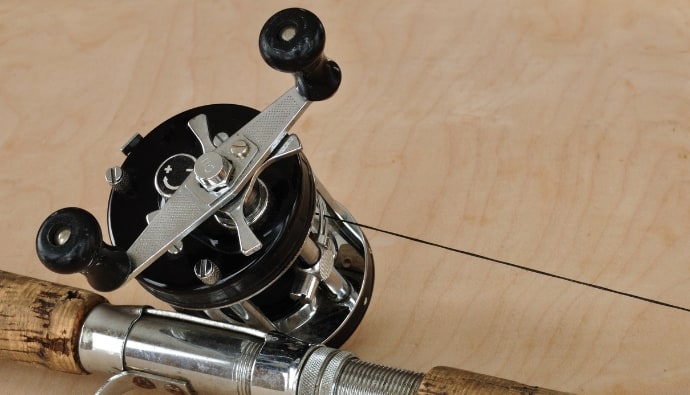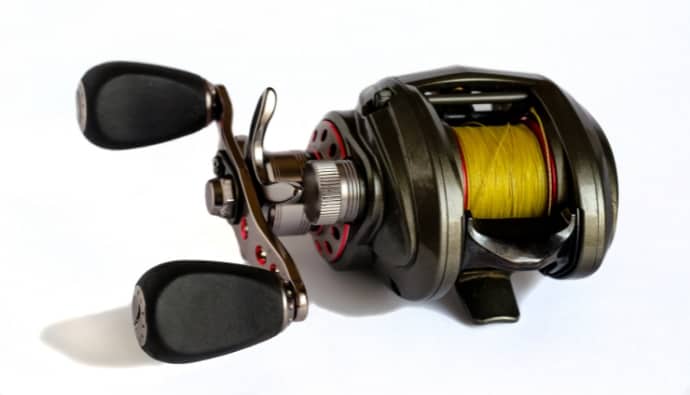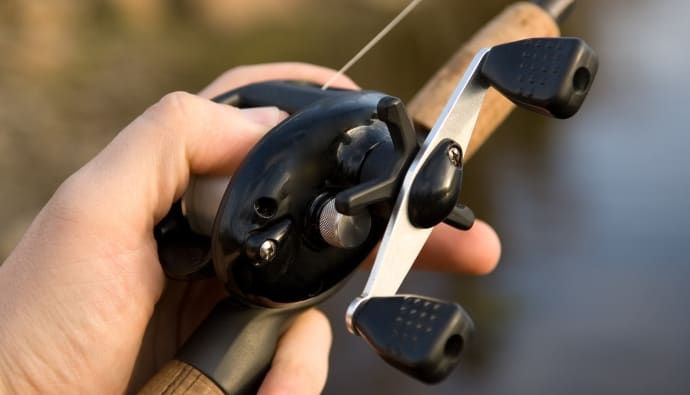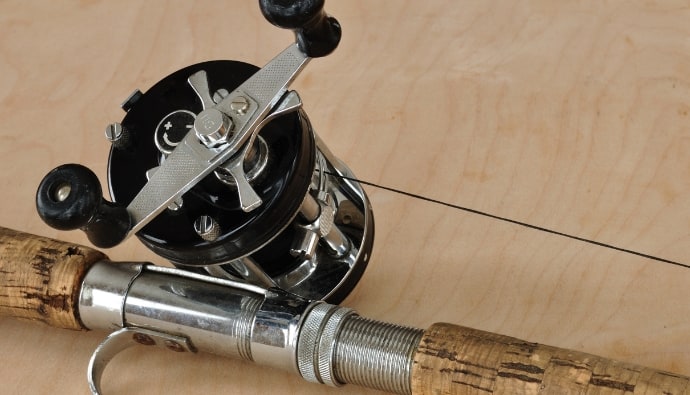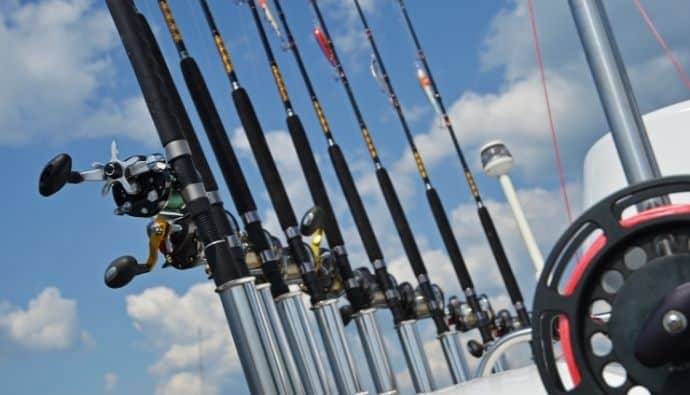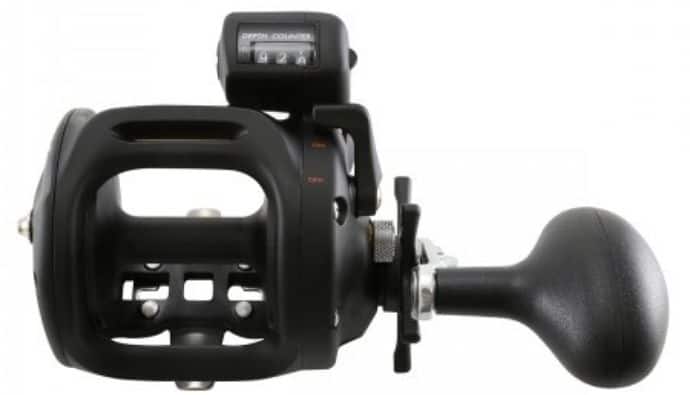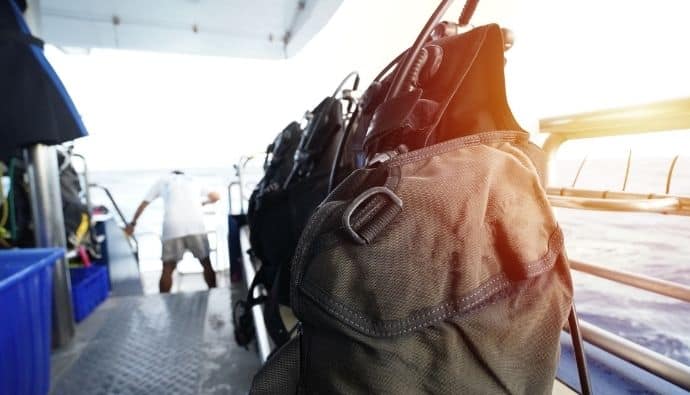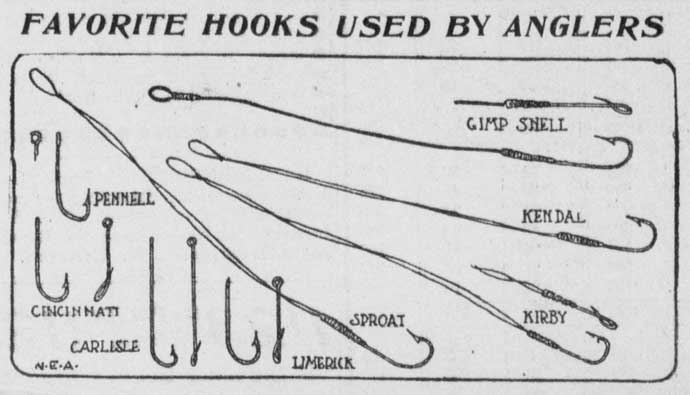The best surf fishing reel is the Diawa BG based on its low cost and robustness. If you’re looking for an upgraded spinning reel, the Daiwa BG MQ is another popular option used by loads of surf fishermen in the Gulf of Mexico. Down in Baja, the Daiwa Saltist is a popular option for going for roosterfish and large amberjacks. For the light-line surf fisherman, almost any size 2000-4000 spinning reel will work, but the Shimano Stradic FL is a great choice. For those who like conventional reels, popular options include the Daiwa Sealine-X or the Akios 656.
10 Best Surf Fishing Reels for 2023 Reviewed
1. Daiwa BG MQ
I had a chance to play with one of the first Daiwa BG MQs and I must say it was an impressive reel. The new monocoque body adds more strength to the frame which is great when you’re reeling in big fish and putting tons of torque on the handle.
The only issue I had about the reel was the price. It’s not insanely expensive, however, when you compare it to the standard Daiwa BG, it’s about double. For me, I’d much rather have two Daiwa BGs that I can beat up on two setups. However, if money isn’t a limiting factor, I highly recommend you check the MQ out.
Read our Daiwa BG MQ Review.
2. Daiwa BG
That is one of the best ultralight spinning reels ever made at any price.
It’s a workhorse. They aren’t the smoothest reels in the world, but they don’t need to be. They can take a beating, hold a bunch of lines, and put the breaks on a big fish.
My BG of choice for surf fishing is the 4500 loaded with a 40lb braid. I then have my mainline attached to a shock leader, which goes to my rig. I learned this from the guys who do serious distance casting down in the Gulf of Mexico. They load up their 14-foot rods and cast a mile. I don’t need that crazy of distance out here in SoCal, so I have it on my 10′ 6 rods.
I have a buddy who has a 5000 and 8000 that he uses on the party boats when he doesn’t want to use his conventional.
Read our Daiwa BG Review.
3. Van Staal VR Series
This surf fishing reel is for you if you need a fully sealed and waterproof construction. You’ll just need to be OK with the sticker price.
This has to be one of the most beautiful spinning reels on the market meant for coastal fishing. It’s extremely lightweight and is forged and machined from 6061-T6 aluminum.
Each model shares the same size reel body, and the only difference is the rotor and spool sizes. These reels also come with a bail-less conversion kit. If you want a surf fishing reel that’ll outlast you, then pick one of these up!
4. Daiwa SS Tournament
This is my first choice and best bang for the buck distance casting or “long casting” reel. I’ve had it for years.
If you are looking to get into distance casting, pick this reel. It was initially designed as a long casting reel, and some say it’s a little bit outdated now, but it’s indestructible, corrosion-resistant, and can be had for the four sizes available in the US.
I’ve caught anything from a trout to a damn sailfish on it. It is a fantastic reel. The gear ratio is 5.1:1.
It was one of the first reels that had long casting geometry. What that means is that it has a longer spool. It’s usually a little bit shallower. And the line lay is superb.
Line lay and geometry are what give you long casting spinning reels
The Diawa was one of the first to do it, and they still make it. It’s kind of like the Z-series. They tried to discontinue it, and people raised all sorts of grief over it because it was too good to let go.
The only downside that I know of on that reel is an absolute non-issue. It’s really neat when you have a reel with a perfect anti-reverse bearing. So the handle cannot spin backward. It’s kind of sexy.
It’s usually on reels with a fair number of bearings, and so they feel good, but here’s a truth about those… It makes no difference.
I don’t think I’ve ever caught so many bonefish on those Daiwa’s. I couldn’t even tell you. I’ve never lost a fish because my reel handles spun backward, even a fraction of an inch.
At times, those anti-reversed bearings, instead of having anti-reverse pull, sometimes those anti-reverse bearings are the only thing keeping that handle from spinning backward, and those things will fail.
So having a, having a little bit heavier hardware inside to keep the reel from spinning the handle backward, such as on the Z-series or on this reel, counts a lot, so that reel is still used by the way in the competition.
This distance casting reel has had lots and lots of records in the past, and it’s still being used. It’s still out there, and it’s been around for 30 years, so it’s a neat one.
5. Diawa Sealine-X
These Non-Mag reels, the SLH, the Diawa Sealine, or the SLX, are virtually identical to a surfcasting reel. The SLX came out a little later. It has a few more bearings, a few more bells, and whistles, but those are two of the best non-mag grills you can buy, without a doubt.
It has solid drag power. Another one that I would add to the list is the Diawa HG Tournament classic.
They have been out of production, but they’re out there. They’re out there.
It’s a very forgiving, non-mag reel and worth looking at. Solid corrosion resistance too. The gear ratio of 6.1:1
6. Daiwa Millionaire Surf Cast Reel
The two very best mag reels on the market, in my opinion, for people who aren’t spending several days a week casting, are the Abu Garcia 6500 Mag Elite and the Diawa 7 M7HTMAG Millionaire.
That surf fishing reel is Sean-proof, idiot-proof, whatever you want. If you turn, it has both centrifugal brakes and magnetic control, as does the mag elite. You can tune the centrifugal brakes to your casting ability or your conditions for both of them.
Windy days want to put a little more break on the reel than on calm days, just as an example. And they both have sound-mag systems.
The Mag on the MAG elite comes in a little bit late. It’s a slider type. You push your thumb along, and it gives you more and more mag as you as your spool empties.
The Diawa has a really nice knob feature. I prefer the Diawa just for the knob feature, but they’re both good reels.
There’s another version called the Mag elite super tuner or ST if you’ve got to have the best of the best without having a real custom tuned or custom-built one; that’s probably along with a few other reels out there. The gear ratio of 5.8:1.
7. Daiwa Saltist
The Daiwa Saltist is a favorite of surf casters like CaboSurfCaster down in Baja. Westley has been using this surf fishing reel to catch big monster fish from shore, including roosterfish and whatever monsters lurk far beyond the waves.
The Saltist features corrosion-resistant ball bearings, a waterproof carbon drag system, and a lightweight Air Rotor design. The 5000 size sports a 33-pound drag and a gear ratio of 5.3:1 and weighs 22.9 ounces.
You can’t go wrong with the Saltist or the Slammer III. If you don’t need a crazy amount of drag, this would be one to go with.
8. Shimano ULTEGRA Ci4 XTC
The Shimano Ultegra XTC has the X-Protect water resistance and Hagane gearing to aid your surf fishing with a highly rigid and durable construction for even the roughest conditions.
This surf fishing reel can cast far, especially the 14000 size, which has the Super Slow 5 Oscillation, which creates a near-perfect line lay.
These are manual closing bails and would make a good pairing with a 9-foot surf fishing rod. Like most surf reels, they can take splashes but do your best never to dunk it. It also comes with one spare spool. For the price, this surf fishing reel is hard to beat!
9. Penn Clash
The Penn Clash is the mid-range option by Penn, and it is great if you are looking to fish artificial baits with a braided line. It comes with the Level-Line system, which should help you reduce those dreaded wind knots.
This surf fishing reel is a step up from the Penn Battle II but isn’t quite as nice or expensive as the Spinfisher or Slammer.
The 5000 size has a respectable 20 pounds of drag and gear ratio of 5.6:1. If you’re going to throw some lures and don’t want to spend a fortune, this is a solid option.
10. Penn Battle III DX
The Penn Battle III DX 3000 is a popular reel among anglers for its durability, quality, and reasonable cost.
It’s not a long caster, but it’s durable. It’s durable. I put it up there with the Diawa BG reel. Phenomenal reel with plenty of corrosion resistance.
Probably one of the best jetty reels. Jetty reels have got to be tough. It’s a good one for that sort of thing. Spool it up with braided lines or simple mono, and you’ll be set.
If you need a surf fishing reel that’s going to show up for your day in and day out, then add this one to your surf fishing gear stash. It won’t let you down. Check out our full Penn Battle 2 Review Guide here.
Remember, you can have the best reel for surf fishing on the market, but if you don’t pair it with a quality surf rod and high-quality surf fishing line…you’re short-changing yourself.

Sean Woodburn’s Rules for Picking the Best Surf Fishing Reels
Rule #1: Match the reel to the task
You may or may not need a long cast reel. You will have lots of options that you may or may not need. So what you need to do is look at where you’re surf fishing, what you’re surf fishing for, and how you’re surf fishing and make decisions based on this.
There are some places where you might want a long cast reel. There are some places where you don’t because there are issues of durability that are better met by other types of reels.
True long cast reels have some features that make them a little more vulnerable, and I’ll get into that in a minute. Sometimes you just need a solid saltwater spinning reel to be a workhorse for non-long casting activities.
Rule #2: A good drag is way more important than extra yards.
If you’re not a seasoned long caster, rest assured. There’s a lot of fish to be had out there at 300 feet, and there’s not a reel out there that won’t cast 300 feet with the right rod and a little bit of technique.
So, before you spend all that money on an expensive long spool reel, which is what a long caster is, it’d be better to go with a reel with a conventional spool and a significant drag.
Rule #3: Durability is way, way, way more important than extra yards.
Having a surf fishing reel that breaks in the middle is horrible, and I’ve seen it happen. I’ve seen spools fly off. I’ve seen handles break. I’ve seen it all.
Having that stuff happened because you brought a $40 Walmart special. It’s just a bad idea. You pay for quality, like a good carbon fiber drag and better bearings.
Rule #4: Don’t buy too large of a reel.
This rule is more of an observation. Very, very, very few fish run a hundred yards. So if you had 100 to 150 yards to your likely casting distance under actual surf fishing conditions, you would have more reels than you probably need.
For example, all the guys 700 feet to 900 feet (pushing a thousand feet) still surf fishing one-third or even one-half of our tournament casting distances.
This is because the rigs for fishing aren’t just as simple as aerodynamic sinkers.
You know, there are few rigs out there that will cast like those anchors. One or two exceptions might be metal spoons and that sort of thing.
Surf Fishing Reels to Consider
When it comes to picking the best reels for surf fishing, Akios made in Britain and is a superb long-cast reel, especially for common surf weights.
The things that give you distance are basically geometry, line lay, and also weight. Most of the good surf reels are gonna come in right at around 600 grams or so, which is why by the way, the Stradic does so well.
The Akios has at least a couple of models out there that are really superb long casters that are available in the US now. Penn has historically made reels for the European and the UK market and hasn’t brought the long-cast reels here.
The Penn Conflict long cast is worth taking a look at. That’s a nice reel. If you want to spend crazy money and get the very best, you start looking at Shimano Aero Technium.
The old Aero Technium, which has been discontinued, might’ve been the best long caster on the planet.
Diawa Basia is another one that is worth looking at. You won’t find long casters using Stella’s. What do you get when you get a Stella? Stella is built like a Rolex.
It’s just a beautiful thing to hold. Every millimeter of that thing is beautifully polished. Perfect. They’re smooth.
They’re also tough. It’s a good surf fishing reel. But the question, you know, is what are you getting for that extra money? Smooth drag, super smoothness, all that stuff, man.
You can take a lot of reels that are in the $100 to $200 range, spend $20 on some Carbontex washers on them and turn a good reel into a GREAT one.
Akios makes some super-tuned reels. Rocket reels. There are some people out there doing great tournament-ready reels, but that it’s not worth the money is what I’m getting at.
If you’re thinking of going for a super-tuned reel, you should think about getting a custom-built reel before you spend $450. And it’ll probably be better than the seven HD super-tuned. That’s the one with the red frame.
The Daiwa M7HG Mag is one that’s got both systems and is so bombproof.
Spinning Reel vs. Conventional Reel
The spinning reel wins with ease of use. However, anyone can learn to control a bait caster in just a session with someone that knows what they’re doing. That’s also the downfall because you can learn bad habits without having a coach or not developing confidence.
Spinning reels are pretty straightforward right out of the gate.
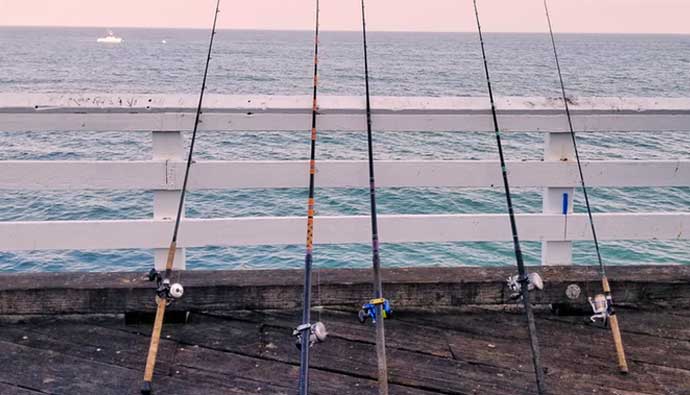
When to Use Braided Line
Surf fishers rarely use braid on conventional reels. It’s uncommon, and I’ll tell you why.
If you try to stop that thing with your thumb, if your thumb catch has slipped, if your leather has slipped, whatever we’re using to keep from burning your thumb, and it can happen with even mono, man, that braid will cut you to the bone. And so we don’t like to use it.
You lay your thumb on that thing, and it’s going to be a rude awakening. So a surf fishing spinning reel is absolutely superior to a braid.
A longer distance is kind of a myth with spinning reels. For people that don’t know how to cast, you get long-distance with them because they don’t know how to control their conventional reel.
Spinning reels are superior with long distances for lighter weights, say under 50 grams. Once you start getting above 50 grams, you’ll find that they’re pretty much held by conventional reels, a so-called baitcasting type of reel if you look up all of the records.
But if you’re casting below 50 grams or even below 100 grams for most people, they will get a better distance saying, say, 75 grams, and blows what I would write about.
The conventional reels outcast them consistently. Also, spinning wheels don’t have greater line capacity. Most reels that are specialty reels for braid come with a shallow spool, so that’s not putting 600 yards of line on a reel that you don’t need.
And a lot of the really high-end carp reels, for example, or high-end surf reels that are designed for braid, have a shallower spool.
Otherwise, they’re kind of neck and neck. They make big spinning reels and make big conventional reels. I wouldn’t say either one has an advantage with line capacity; however, if you want to use braid, definitely on the spinning wheel.
Just FYI, we also avoid having braid on boat reels. Most people have decided that they need to use it. They’re using may be a small reel and want more capacity.
Whatever they use, they put a mono-top shop because it’ll cut through your glove if you try to grab that braid.
If you’re dealing with an aggressive, even at 30, 40 pounds sailfish, that’s really feisty. And you grabbed that braid, you know, it’ll cut you to the bone.
Surf Fishing Reel Brakes
One type of brake is not better than another. They have different applications and tension knobs.
When they use the tension knob, most people will put whatever weight they’re going to cast and then back it off, and loosen it until their weight starts to drop.
And that’s probably a good place for them to start. It does help prevent backlashes, but it’s not a break.
It makes sure that the reel doesn’t start too fast. As we become more and more adept, you’d be amazed at what you’re casting.
You’ll have the tension knob off. You’ll be using it to control side-to-side motion. We want it to spin as freely as possible.
Centrifugal Brakes
There are lots of ways those things are put together. The old Abu Garcia Ambassadors had two break boxes in them, and a lot of the current ones have six break boxes in them, which blocks you make a difference as they spin against the rim that they create and drag on it.
It has to do with how much friction there is, and then some of the sophisticated things that Daiwa and Shima, in particular, have been doing with aerodynamic air things in the reel are pretty amazing.
But sticking to centrifugal breaking, or centrifugal, is what our British friends call it, is an effective way. Those Daiwa’s SLH and SLX series tune properly and are extremely controllable, like the Penn Squall.
Magnetic Brakes
Mags do one of two things for us; they either give us a little bit more break, so we set those breaks up a little bit light, but turn the mag all the way up, which gives us a little bit more control.
The Diawa HG Mag millionaire is a great example, and you can use the mag in conjunction with the centrifugal brake. We use mags alone in either tournament casting or with a very experienced caster.
Someone who’s using mags alone usually has a lot of skill, and they’re doing things like using different viscosity oil in their bearings. Even ceramic bearings, which don’t need oil, they’ll use different oil grades to slow the reel depending on things like temperature and how far they’re casting.
That’s really sophisticated stuff.
So, the two reels that I mentioned earlier, the Diawa and the Abu Garcia Mag elite, both have both types, and they’re very easy to tune.
It’s one of the reasons I love him so much because you can get a lot of performance out of those types of things pretty easily.
Fishing Line Diameter Matters
It’s a myth to believe that you don’t really lose distance on a conventional reel. That’s not true. Even a few thousandths make an enormous distance difference when casting.
And I can direct you to some YouTube channels where guys have tested, say, 20 versus 28 thousandths of a millimeter.
Three-thousandths of a millimeter can make a five to seven percent difference in the distance of a cast. Going down to 18 thousandths is what we use for 7.5 grams. It’s doubled from 25 thousandths. So with a quarter of an ounce, that’s just something to be aware of. That’s something to be aware of.
The Best Braid to Mono Knot
There is only one not to use to tie your braid to your mono because you’re going to have a mono top shot. No matter what, that’s called the FG knot. You’ll see people talk about other knots, and they don’t understand knots.
I have a knot testing machine, so I’ve tested them, and I’ve tested everything against everything. And the FG is, is absolutely the superior knot for mono-to-braid connection. When another knot breaks, the FG stays. If you think I’m wrong, send me your knot, and I’ll test it for you.
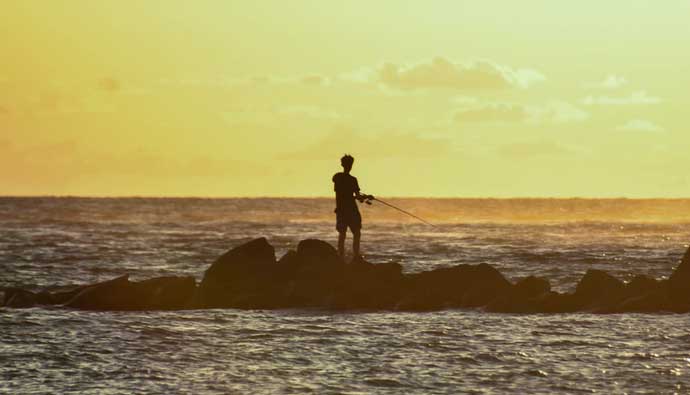
How to Care for Your Surf Fishing Reel
To ensure the longevity of your reel, make sure you give it a good clean after every saltwater, brackish water, or dirty freshwater fishing trip.
The easiest way to clean a reel is to give it a gentle rinse with fresh water. It pays to remove the spool and handle every now and then and give any moving parts a little oil. A little bit of TLC can go a long way to extending a reel’s life.
Avoid opening any reel casings as they’re tightly packed with small washers, springs, and cogs, and losing one can be painful. Leave this to a registered technician.
Surf Fishing Reel Buyer’s Checklist
- What type of fish will you be going after? This is important to know to decide which size reel and line will best suit you.
- What type of conditions do you expect to be surf fishing in? If you plan to be primarily in saltwater, you will want to make sure the reel you choose is ‘watertight” for corrosion resistance from the bearings to prolong the life of your reel. Corrosion-resistant gear is crucial!
- What is your skill and experience level? This is important in deciding the difference between a conventional and a surf fishing spinning reel, in part because of the ease of use of the surf fishing spinning reel.
- What is your budget? There are many reels out there that are budget-friendly without necessarily sacrificing quality. Cheaper gear generally means less corrosion resistance.

Frequently Asked Questions
It’s a personal preference, but I like either 3000 or 4000 for most surf fishing adventures for spinning reels.
Quality and strength of the housing, water tightness (to help prevent corrosion), and a number of bearings (for durability and added strength).
Place your thumb on the spool to prevent the line from coming off while moving the lever back to the “Free” position. Bring the rod back and then forward in one swift motion, releasing the spool during the forward motion and allowing the bait to be cast.
Preventing backlash takes practice! Stop the spool with your thumb as the bait enters the water, then move the lever to the correct position for your application.
For this cast, start with about five feet of line between the rod tip and lure. If you are right-handed, your feet will be about the width of your shoulders apart and point down the beach to your right.
With the rod held high, start the lure on a swing that carries it up and away at right angles from the water. When that swing is completed, begin the forward cast.
This is a relaxed, unhurried movement, and power comes from the arms, shoulders, and rotating motion of the upper body.
An ideal surf-fishing rod is 12 to 15 feet long with large line guides. Pair it with a large saltwater spinning reel and 20 to the 25-pound test line. With that equipment, you’ll be able to cast a weighted bait up to 100 yds.
Reel Takedown:
On the cranking side of the reel, you will see a little round chrome-retaining pin. Unscrew this pin in the counterclockwise direction. It will not come all the way out, but once it is on, you will want to pull on it and feel it slide back 1mm to 2mm.
Hold it in this position with your left hand, and then turn the crank counterclockwise. The whole Side plate should turn and then come free from the reel frame. Now slide the spool out, and you are ready for business.
Installing The Mags:
You will install two ¼ x ¼ magnets and magnet cups on the side plate opposite the gearbox/crank side of the reel.
Before you glue or epoxy them in, be sure to clean the area with lighter fuel. It’s a good idea to clean the backside of the mag cups with lighter fuel as well.
Glue:
Crazy glue gel works great but if you want a permanent fix, use epoxy. Apply glue or epoxy to the backside of the mag cups and then install them side by side onto the inside of the plastic side plate. They will be a perfect fit between the little plastic fins on the side plate.
Place them on the bottom side of the side plate rather than the top side, as in the picture. This will allow the clicker to function correctly.
Do not push them up to tight against the round clicker spring. This will make the clicker malfunction. Hold the cups firmly for a minute or two until the glue sets.
Putting In The Magnets:
Once the glue has dried, you are ready to install the magnets. You simply place the magnets inside of the magnet cups where they are held in place by the magnetic force.
By placing one magnet in with the north field facing towards the spool and the other with the south field facing the spool, you will achieve maximum mag force on the spool.
If the spool is still too fast with the mags in the North-South configuration, you can take small flat washers and place them inside the magnet cups to shim the magnets closer to the spool.
If the reel is too slow for you with the mags in the North-South configuration, you can flip one over and put them in so they are both North-North or South-South.
This will create less magnetic force and allow for a faster spool. If it is still too slow, simply remove one of the magnets from the magnet cup.
Putting The Reel Back Together:
Simply slide the spool back in. Then place the gearbox/crank side plate back into the frame. You will see little groves where the side plate lines up with the frame.
Hold up the retaining pin out and then twist the side plate back into place. Once it stops turning, let go of the retaining pin, and it should drop down into the reel.
Next, tighten the retaining pin by twisting it in a clockwise direction. It should screw in with little effort. If it feels like it is not screwing in or hard to turn to, STOP! Unscrew it and twist the spool until you feel it drop into place.
Once the Pin is in place and has tightened it up, you are ready to go surf fishing.





 Facebook
Facebook YouTube
YouTube
